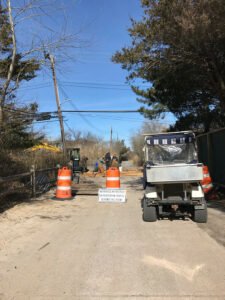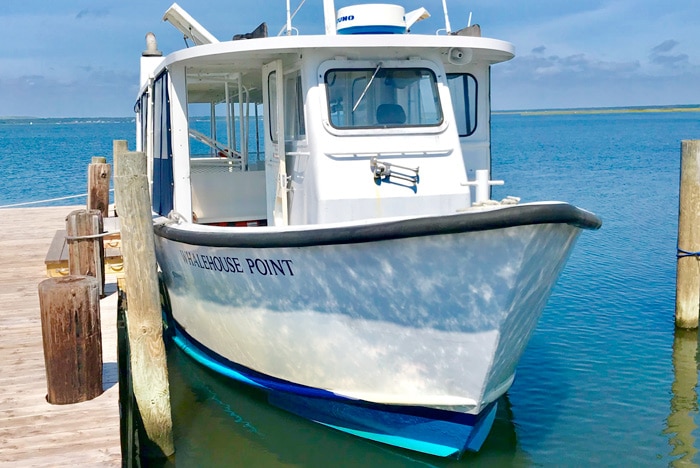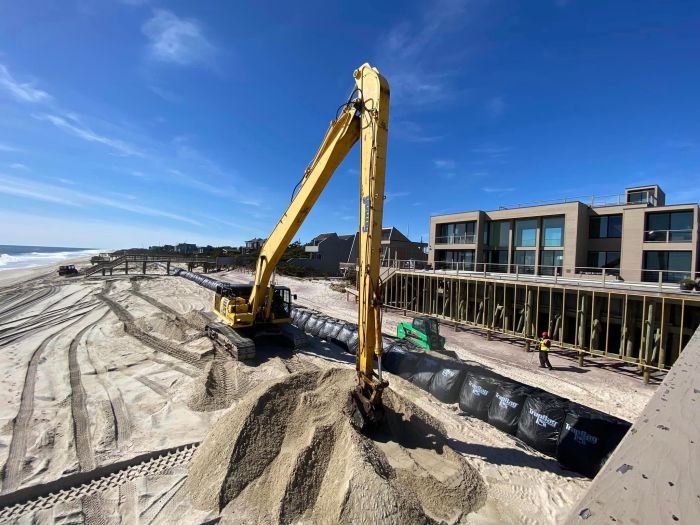
By Timothy BolgerWhen the sun sets on summer and Tumbleweed Tuesday dawns on Fire Island, the din of construction replaces children’s laughter and carefree tourists’ chatter, as the off-season marks the return of renovation season. While much of the work is home improvement, one stretch of road repairs on the west end is worrying many of the barrier island’s about 400 year-round residents.The Village of Saltaire is replacing the nearly one-mile stretch of Lighthouse Promenade – the main drag that connects with Burma Road, which also goes by Midway, Central Walk, and a few other names, through the middle of much of the island – and the village’s water main that runs beneath it. Replacing the concrete village street with a boardwalk has been the focus of a years-long debate in Saltaire. But since the work requires closing a critical stretch of the island’s main artery and forcing traffic onto the oceanfront during winter, when the beach is typically smaller, driving proved tricky last season when the first phase of the work began in the village’s east end from East Walk to Beacon Walk. This off-season, all eyes are on Saltaire to make sure the next phase goes more smoothly.“The work diverted vehicle traffic most weekdays, requiring motorists to keep a closer eye on the shoreline when planning travel,” Shoshanna McCollum, the News’ editor and year-round Ocean Beach resident, reported in May. “This work was not without its share of complaints by year-round Fire Island residents.”Since the creation of New Inlet in Superstorm Sandy seven years ago, year-round Cherry Grove, Fire Island Pines, and Davis Park residents can no longer leave the island across the Smith Point Bridge. Driving over the Robert Moses Causeway bridge – a route that requires passing through Saltaire, the second western-most community on the beach – is now the only way to leave. Although that hasn’t proven problematic for everyone.“For me, the inconvenience was fairly minimal,” said Mike Fisher, of Cherry Grove, who has lived year-round for about a dozen years. He’s more concerned with how filling the massive potholes in the stretch of Burma Road between Kismet and the checkpoint so patients don’t get hurt when riding in ambulances.The Saltaire road work has made commuting difficult for Byron Chenault, who has lived year-round in Ocean Beach for four years, and works as an Ocean Beach Police Department dispatcher, Emergency Service Coordinator for Point ‘O Woods, and secretary of the Fire Island Year Round Residents Association (FIYRRA).“There were a couple of hiccups,” Chenault said, recalling how parts of Lighthouse Promenade were so soft when it reopened that trucks sometimes got stuck in the soft sand. He also recalled how sometimes a sign set up to alert drivers to whether the road was open or closed wasn’t always updated in a timely fashion, causing some drivers to have to turn around upon reaching Saltaire when they realized the road was closed despite the sign saying it was open.“Some older residents who live east [of Saltaire] weren’t comfortable driving on the beach,” he added. In the worst-case scenario of the road being closed and the shore being small during the day, Chenault said he would have to pause while driving between waves and opposing traffic. “It wasn’t the most impossible thing, but would make travel more interesting.”To Saltaire’s credit, Chenault said a text message system set up for year-round residents alerting them to the road’s status helped, at least for those on the list. And in the event of an emergency, the village managed to open the road in time for ambulances, fire trucks, police, and utility vehicles to pass in time, he said, noting that he’s confident the process will go more smoothly this off-season.Ocean Beach Fire Department Chief Ian Levine agreed. He said Saltaire “is doing what has to be done for Fire Island to keep existing.” He noted that the project workers were always accommodating when there was a need to open the road in emergencies, and kept it open when the response vehicle needed to make the return trip back. In addition, they were cooperative when fire department vehicles had to be taken off for repair or maintenance, which had to be done on weekdays when the mechanic shops are open. He also recalls cement work was done in Fair Harbor a couple years ago that similarly had its share of inconveniences, but people managed.It’s not that the Lighthouse Promenade work is unnecessary. It’s the last of Saltaire’s streets to be rebuilt with a new flood-resistant elevated boardwalk design since the storm. And the village has been talking about replacing its water main for at least the past decade. U.S. Sens. Charles Schumer and Kirsten Gillibrand (D-NY) announced back in March that the job qualified for $2.5 million in Federal Emergency Management Agency (FEMA) reimbursements since the road was damaged in Sandy.“With these funds, the Village of Saltaire will be able to repair the Lighthouse Promenade and its vital roadway, which serves the entire barrier island as the only emergency access route in the event of an evacuation,” Schumer said.“The village is pleased that FEMA understands the strategic importance of Lighthouse Promenade for all of Fire Island, as well as the importance of its reconstruction with a design and materials that meet the highest standards of flood resiliency,” added Saltaire Mayor John Zaccaro Jr. He noted that the walk elevation has been raised approximately a foot to contend with the constant flooding in the east end of the village and the new 12-inch water main is a significant upgrade from the existing 75-year-old 6-inch main, improving water pressure, flow, and fire protection throughout the village.While the funding is good news for Saltaire, the road closures that the work creates remains an issue for the rest of the island.“They are not letting anyone through while work is being done,” said FIYRRA President Dawn Lipper. “The year-round residents who I think really get the brunt of the daytime restriction through Saltaire are the ones who live in Fair Harbor and Dunewood. They now have to travel east to the Atlantique cut to leave the island between 8 a.m. and 4 p.m. I would find that truly annoying.”She notes that as a Kismet resident, she and her neighbors are the lone community west of Saltaire that doesn’t usually have to deal with the road closures, except for Kismet residents that work east of Saltaire or need to travel eastbound on foot, bicycle, or golf cart for any other reason. The biggest concern, of course, is what happens in case of an emergency.“Our concerns in Kismet and for year-round residents across the island does center around mutual aid response in the event of a fire or EMS or law enforcement response during the daytime hours,” Lippert said. “Saltaire has assured everyone that they will open up the area ASAP and so far it has not been an issue. But it will be an issue, if it becomes an issue, if you know what I mean.”Water main installation work is scheduled to resume on Sept. 16, at Richards Walk, with a targeted completion date of April 30, 2020. Installation of the new nine-foot-wide timber walk is scheduled to start on Oct. 21 in the same area with the same completion date. While the road will be open on weekends and be closed 8 a.m. to 4:30 p.m. each work day, the village announced that it has a plan to reopen it for emergencies – 20 minutes after first responders notify the village.Work area will be covered/bridged/matted for road reopening so vehicles can travel over the area of current work,” Saltaire officials wrote in their plan posted on the village website. The plan requires that vehicles travel over some sand portion road where it has been ripped up and bridging placed over areas under construction when the road is reopened.When the work reaches the final leg between Pacific and West walks, Saltaire- permitted, non-overweight traffic will be allowed to detour around the area of work north of Lighthouse Promenade on designated walkways.Will the plan go more smoothly than last off-season? As they say, stay tuned.






























